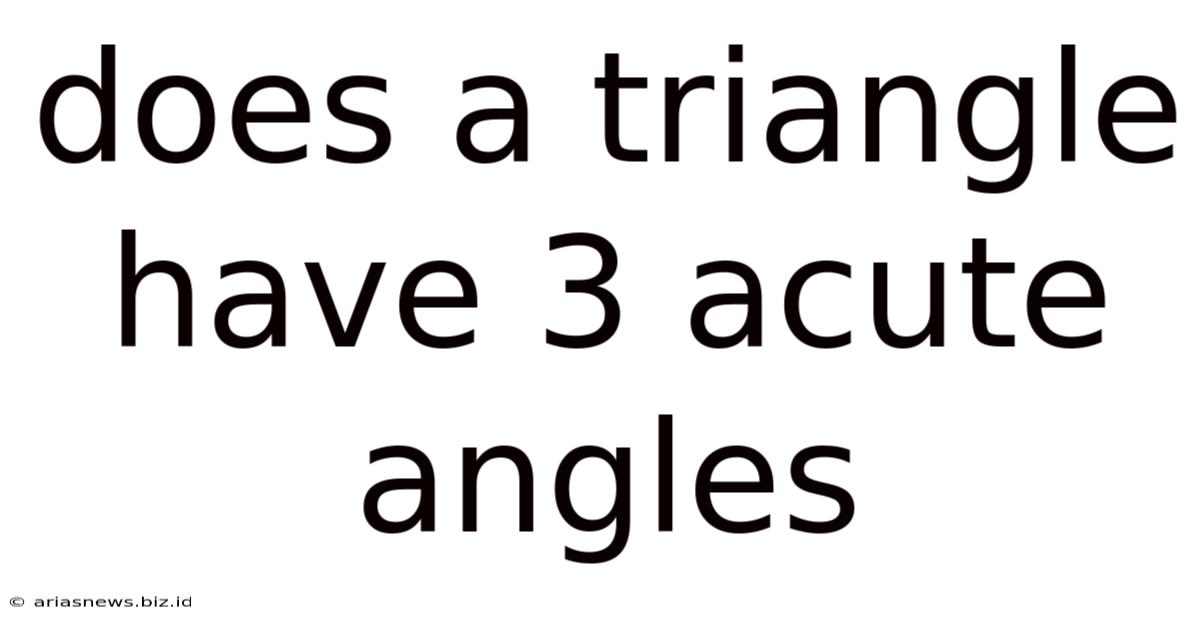Does A Triangle Have 3 Acute Angles
Arias News
May 12, 2025 · 4 min read

Table of Contents
Can a Triangle Have 3 Acute Angles? Exploring the Geometry of Triangles
The question of whether a triangle can possess three acute angles is a fundamental concept in geometry. The answer, surprisingly to some, is a resounding yes, but understanding why requires delving into the core properties and theorems governing triangles. This exploration will not only answer the central question but also illuminate related geometrical concepts, providing a comprehensive understanding of triangle classifications and angle relationships.
Understanding Acute, Obtuse, and Right Angles
Before diving into the specifics of triangles, let's define the types of angles we'll be discussing:
- Acute Angle: An angle measuring less than 90 degrees.
- Right Angle: An angle measuring exactly 90 degrees.
- Obtuse Angle: An angle measuring greater than 90 degrees but less than 180 degrees.
These angle classifications are crucial for categorizing triangles based on their internal angles.
Types of Triangles Based on Angles
Triangles are categorized into three types based on their angles:
- Acute Triangle: A triangle with three acute angles (all angles less than 90 degrees).
- Right Triangle: A triangle with one right angle (one angle equal to 90 degrees).
- Obtuse Triangle: A triangle with one obtuse angle (one angle greater than 90 degrees).
It's important to note that a triangle cannot have more than one obtuse angle or more than one right angle. This is because the sum of the interior angles of any triangle always equals 180 degrees. If you had two obtuse angles (each greater than 90 degrees), their sum alone would already exceed 180 degrees, violating this fundamental rule. The same logic applies to having more than one right angle.
Proving the Existence of Acute Triangles
The question, "Can a triangle have 3 acute angles?", is essentially asking whether an acute triangle exists. The answer is unequivocally yes. Consider the following:
- The Angle Sum Theorem: The sum of the interior angles of any triangle is always 180 degrees. This is a cornerstone of Euclidean geometry.
- Constructing an Acute Triangle: We can easily construct an equilateral triangle – a triangle with three equal sides and three equal angles. Since the sum of angles must be 180 degrees, each angle in an equilateral triangle measures 60 degrees (180°/3 = 60°). Since 60 degrees is less than 90 degrees, an equilateral triangle is, by definition, an acute triangle. This proves the existence of at least one type of acute triangle.
This simple example demonstrates that it's perfectly possible to have a triangle with three angles all measuring less than 90 degrees.
Exploring Other Acute Triangles
Equilateral triangles are not the only acute triangles. Numerous other combinations of angles can result in an acute triangle, as long as the following conditions are met:
- All angles are less than 90 degrees.
- The sum of the angles is 180 degrees.
For example, a triangle with angles of 70°, 60°, and 50° is an acute triangle. Similarly, a triangle with angles of 80°, 70°, and 30° is also an acute triangle. The possibilities are virtually infinite, as long as the two constraints mentioned above are satisfied.
Misconceptions and Common Errors
A common misconception stems from the intuitive understanding that larger angles imply larger sides. While there's a correlation, it's not a strict rule, especially when considering angles less than 90 degrees. One might mistakenly assume that three acute angles would somehow “not fit” together to form a closed triangle. However, the angle sum theorem elegantly refutes this.
Practical Applications and Real-World Examples
Acute triangles are prevalent in numerous real-world applications and structures:
- Architecture: Many architectural designs incorporate acute triangles for aesthetic and structural reasons. The sloping roofs of many houses, for instance, utilize acute angles.
- Engineering: In engineering, acute triangles often appear in structural frameworks, ensuring stability and load distribution. Trusses, for example, frequently utilize acute triangles.
- Nature: Natural formations, such as crystalline structures, often exhibit acute angles. The facets of certain crystals showcase the beauty and mathematical precision of acute triangular formations.
Advanced Concepts and Related Theorems
The study of acute triangles can extend into more advanced geometrical concepts:
- Trigonometry: Acute triangles play a central role in trigonometry. Trigonometric functions (sine, cosine, tangent) are defined based on the ratios of sides in right-angled triangles. However, these functions can be extended and applied to acute triangles as well through techniques like the Law of Sines and the Law of Cosines.
- Geometric Proofs: Proving geometric theorems often involves constructing auxiliary lines and creating acute triangles to facilitate the demonstration of congruency or similarity between different figures.
Conclusion: The Ubiquity of Acute Triangles
In conclusion, the answer to "Does a triangle have 3 acute angles?" is a definitive yes. The existence of acute triangles, including equilateral triangles, is firmly established within the principles of Euclidean geometry. Understanding this fundamental concept opens doors to exploring further intricacies of triangle geometry and its numerous applications in various fields. The angle sum theorem, the cornerstone of this understanding, highlights the elegant simplicity and power of mathematical principles in shaping our understanding of the world around us. The ubiquity of acute triangles in both theoretical mathematics and practical applications underlines their significance in the world of geometry and beyond. Their characteristics and properties continue to inspire exploration and innovation in various scientific disciplines.
Latest Posts
Related Post
Thank you for visiting our website which covers about Does A Triangle Have 3 Acute Angles . We hope the information provided has been useful to you. Feel free to contact us if you have any questions or need further assistance. See you next time and don't miss to bookmark.